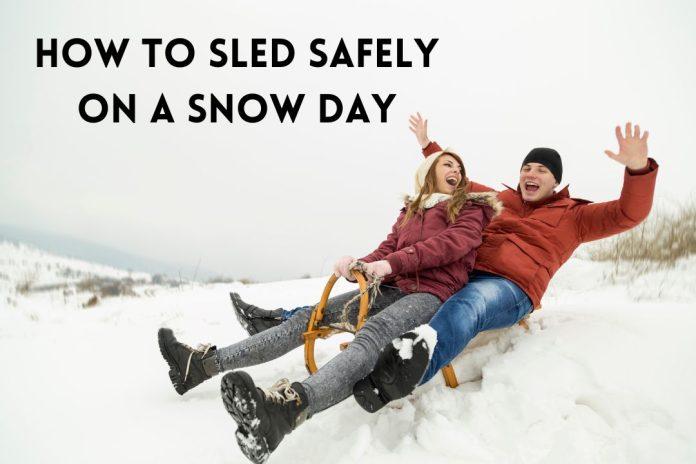When sledding on a snow day, it is important to choose a safe and appropriate location. Avoid hills that are too steep or have obstacles, such as trees, rocks, or buildings. Look for a wide, clear hill with a gentle slope free of obstructions. Additionally, ensure the location is not too crowded and has enough space to stop at the bottom of the hill.
It is also important to check the weather conditions and avoid sledding on hills that are icy or have hard-packed snow. These conditions can make it difficult to control the sled and increase the risk of injury. Finally, ensure respect for private property and only sled on hills open to the public or with permission from the owner.
Dress Appropriately
Before heading out to sled on a snow day predicted by snowday predictor Canada, dress appropriately for the weather. Wear layers of warm clothing that can be easily removed if you get too warm. It is also important to wear waterproof boots, gloves, and a hat to keep your extremities warm and dry. In addition, wearing a helmet can help prevent head injuries in case of a collision or fall. Make sure the helmet fits properly and is secured tightly before sledding. Finally, consider wearing goggles to protect your eyes from snow and wind. This can help prevent injuries and keep you comfortable while sledding.
Inspect Your Sled
Before using your sled, inspect it for any damage or defects. Check the sled for cracks, sharp edges, or loose parts that could cause injury. Additionally, make sure the sled is the appropriate size and weight for the rider and the conditions of the hill.
If the sled has any damage or defects, do not use it and find a safe and appropriate replacement sled. Using a damaged sled can increase the risk of injury and make sledding less enjoyable. Following the manufacturer’s instructions and recommendations when using the sled is also important. This can help ensure the sled is used safely and appropriately.
Learn How to Stop
One of the most important safety tips for sledding is learning to stop. Before heading down the hill, practice stopping techniques such as dragging your feet, rolling off the sled, or using a hand brake.
It is important to avoid stopping suddenly, as this can cause the sled to flip or collide with others. Instead, gradually slow down and steer the sled to a safe stopping point at the bottom of the hill. Practice stopping techniques before sledding to ensure you can stop safely and effectively when needed.
Follow the Rules
When sledding, it is important to follow the rules and regulations of the location. This may include rules such as staying on designated trails, not sledding under the influence of drugs or alcohol, and avoiding dangerous maneuvers or stunts.
Additionally, it is important to be respectful of others and avoid collisions or dangerous behavior that can cause injury. Follow the rules and guidelines to ensure a safe and enjoyable sledding experience.
Avoid Sledding Alone
It is important to avoid sledding alone and always have a partner or group when sledding. This can help ensure someone is available to provide assistance if needed and can alert others in case of an emergency.
Make sure to communicate with your sledding partners and establish a plan for emergencies. This can help prevent accidents and ensure everyone is prepared for any situation. Finally, keep an eye on each other and avoid reckless or dangerous behavior that can cause injury.
Check for Obstacles
Before heading down the hill, check for any obstacles or hazards. This can include rocks, trees, or other objects that can cause injury or damage to the sled.
Additionally, make sure to avoid areas with ice patches or hard-packed snow. These conditions can make it difficult to control the sled and increase the risk of injury. Keep an eye out for any changes in the terrain and adjust your sledding accordingly to avoid any obstacles or hazards.
Keep a Safe Distance
It is important to keep a safe distance from other sledders when sledding. Avoid following too closely or overtaking other sledders, as this can increase the risk of collision and injury.
Also, avoid sledding in areas with many people or crowded hills. This can make it difficult to control the sled and increase the risk of collision or injury. Keep a safe distance from others while sledding to ensure a safe and enjoyable experience.
Be Prepared for Emergencies
When sledding, it is important to be prepared for emergencies and have a plan in case of an accident or injury. Bring a first aid kit and know basic techniques for injuries such as cuts, bruises, and sprains.
Also, bring a charged cellphone and plan to contact emergency services if needed. Ensure you communicate your location and any injuries to emergency services for a timely response.
Finally, stay calm and keep others calm in an emergency. This can help prevent further injury and ensure a safe and effective response.
Have Fun Safely
Finally, remember to have fun while sledding safely. Follow these tips and guidelines to ensure a safe and enjoyable experience. Respect others and the location, communicate with your sledding partners, and be aware of your surroundings. Stay safe, and have fun!
